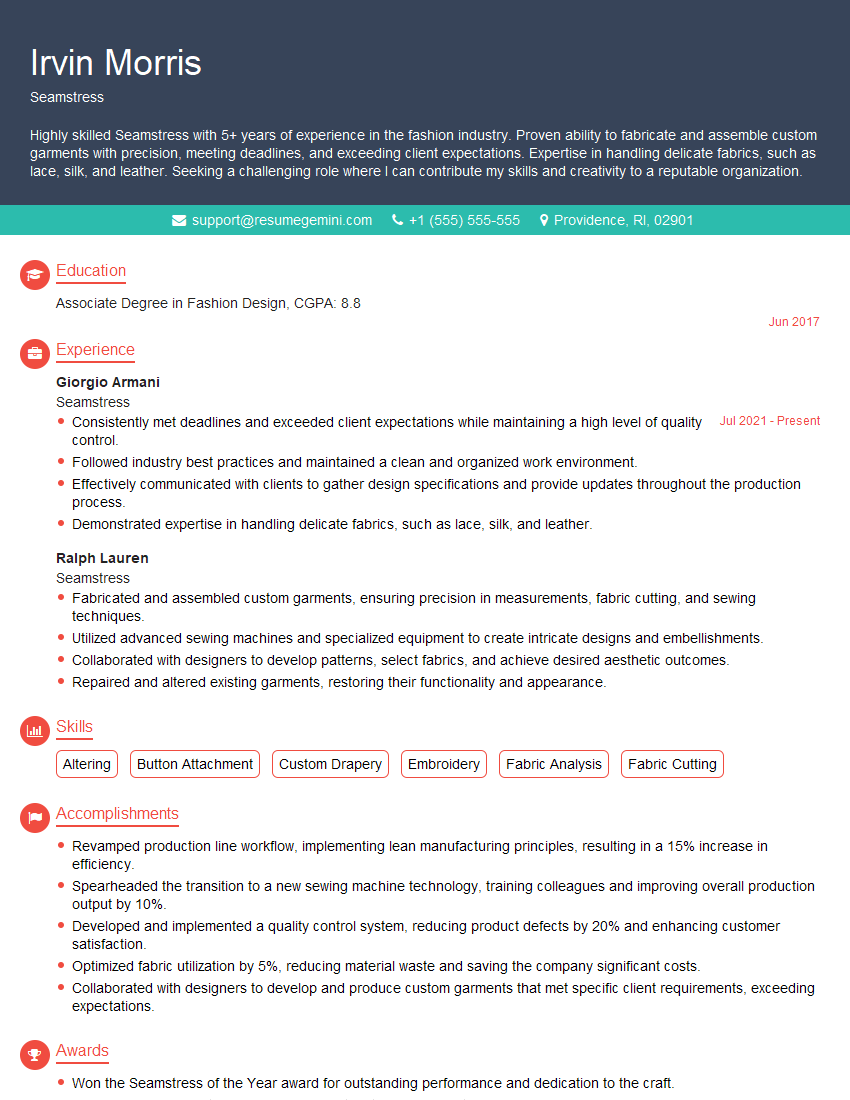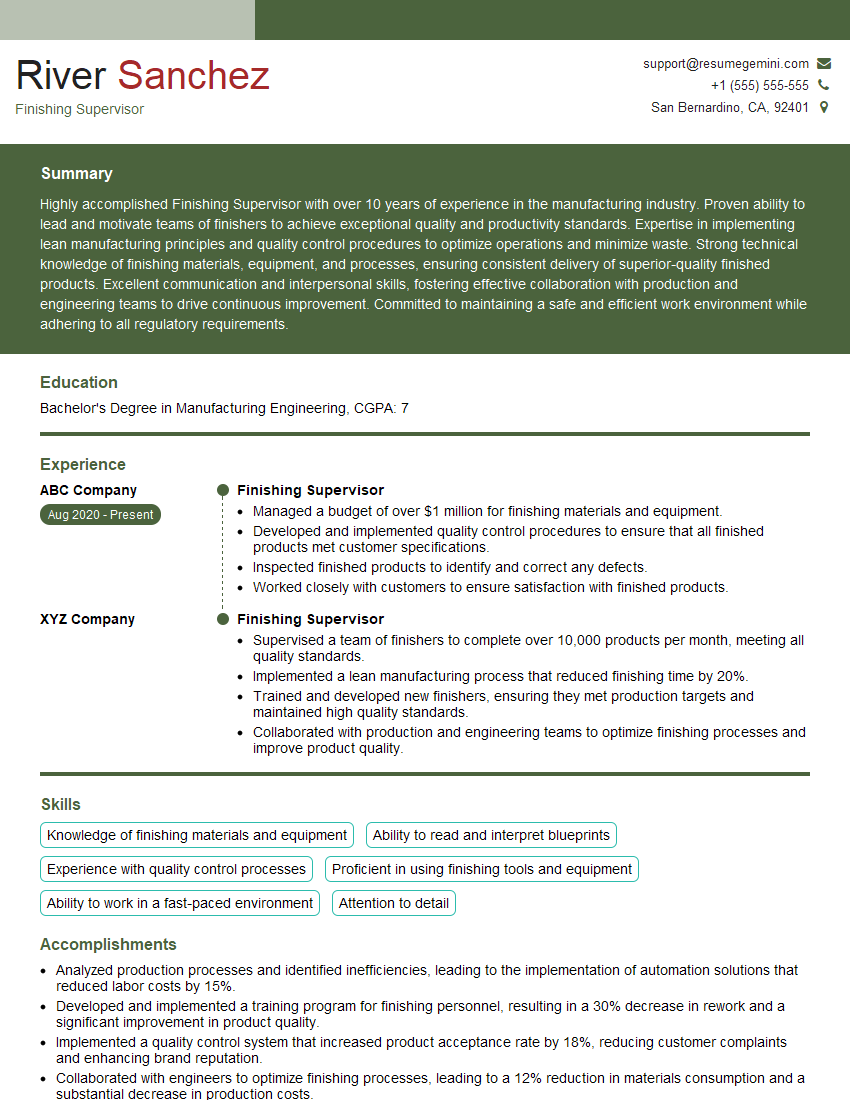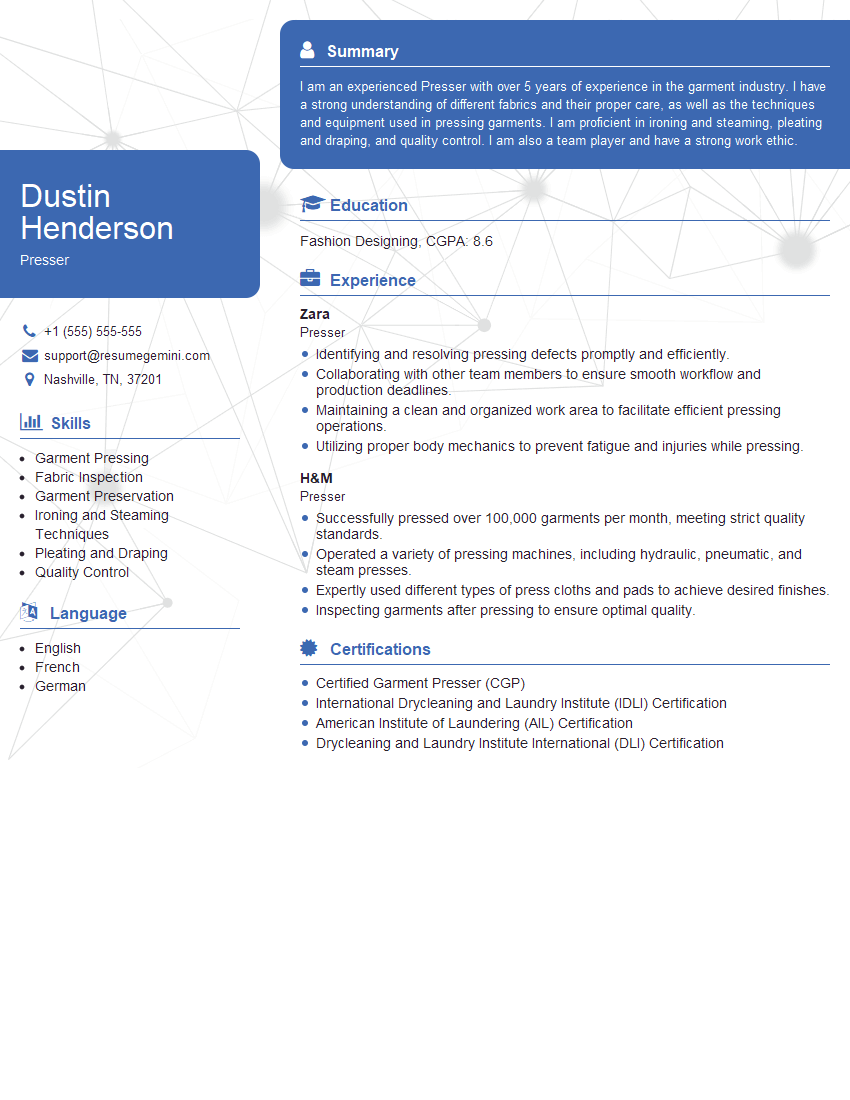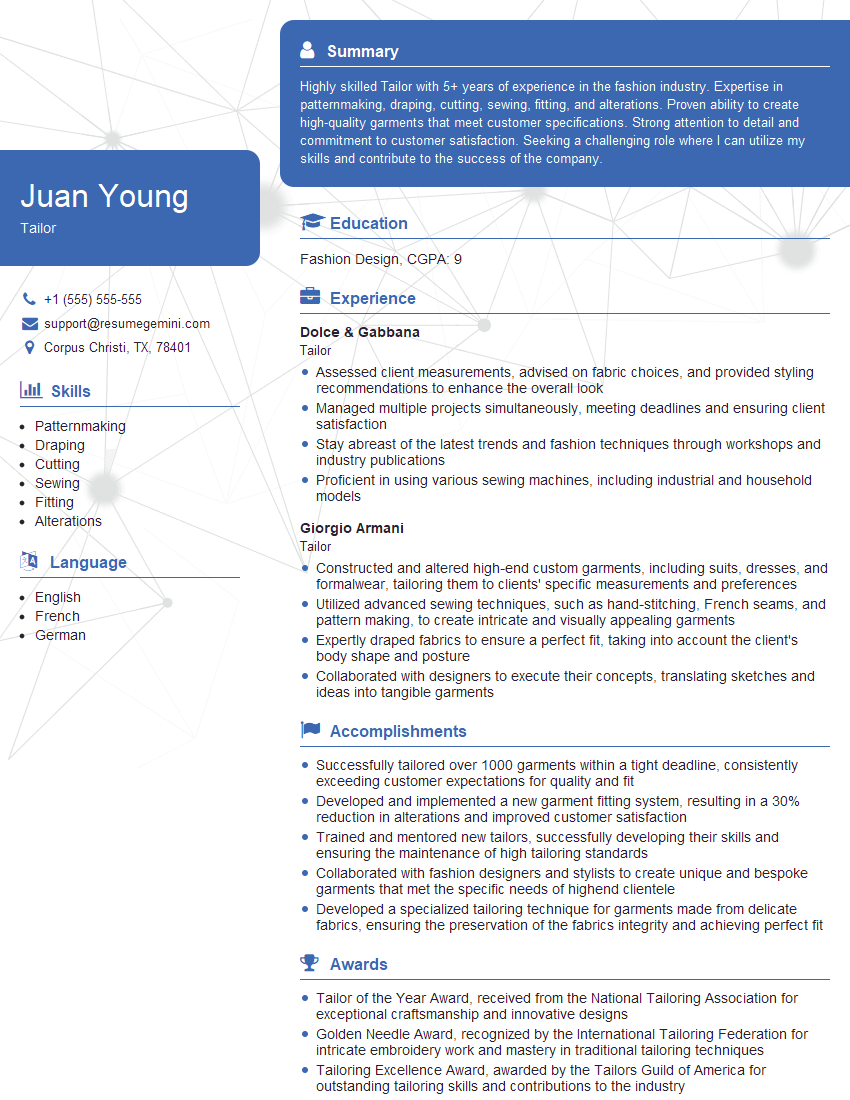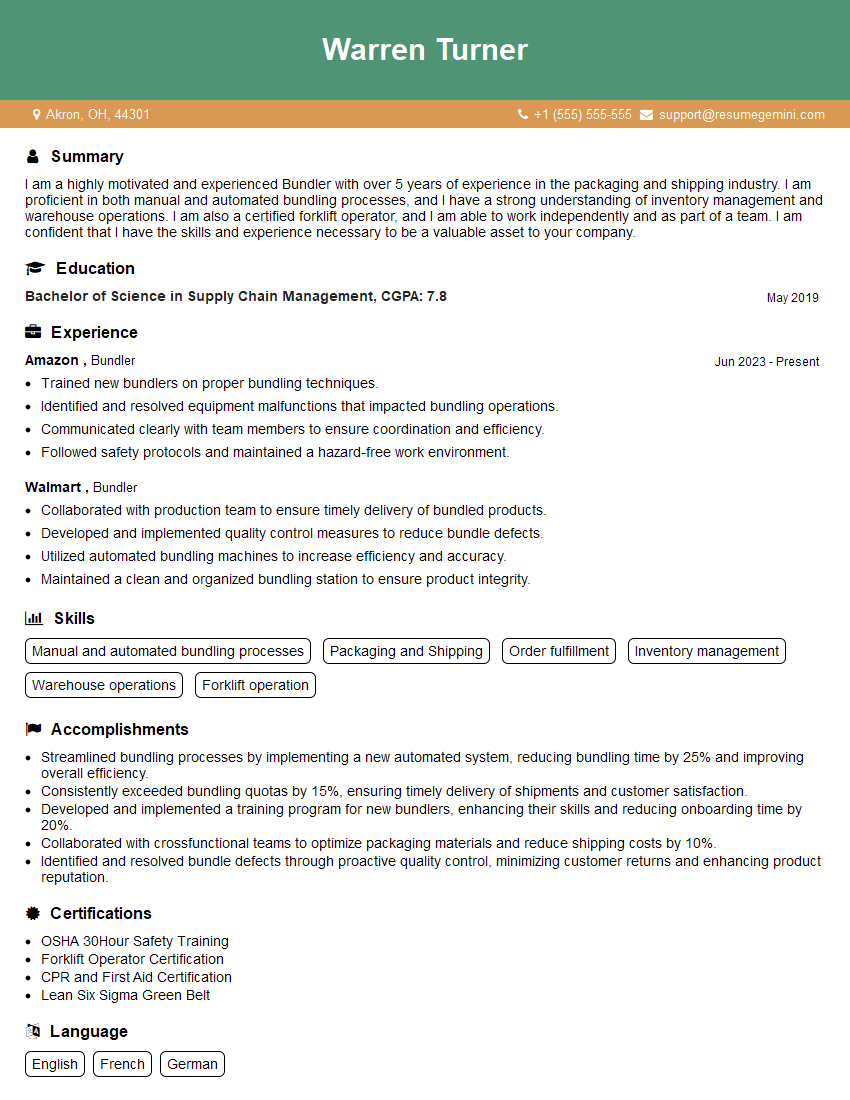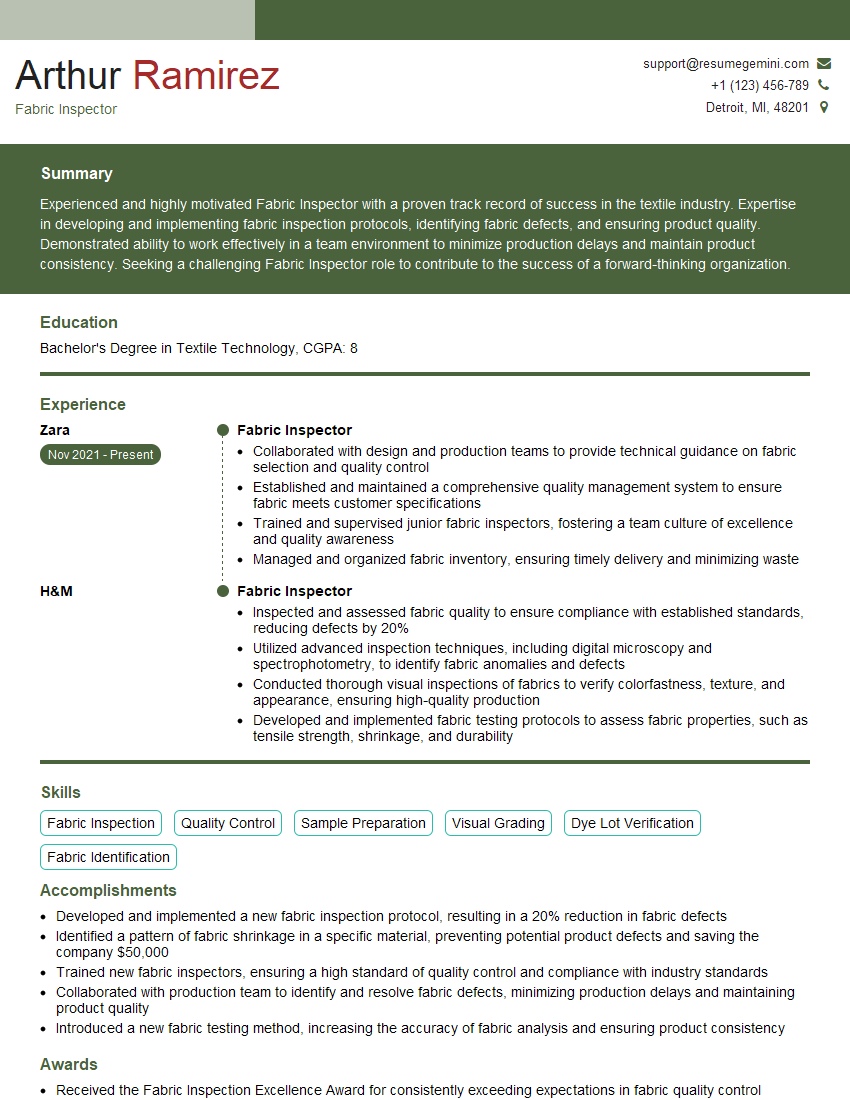Feeling uncertain about what to expect in your upcoming interview? We’ve got you covered! This blog highlights the most important Garment Construction and Finishing interview questions and provides actionable advice to help you stand out as the ideal candidate. Let’s pave the way for your success.
Questions Asked in Garment Construction and Finishing Interview
Q 1. Explain the different types of seams used in garment construction.
Seams are the foundation of garment construction, joining fabric pieces together. The choice of seam depends on the garment’s style, fabric type, and desired durability. Here are some common types:
- French Seam: A very clean, strong seam, ideal for fine fabrics. It encloses all raw edges, providing a high-quality finish. Think of delicate blouses or lingerie.
- Flat-felled Seam: Extremely durable, often used in denim or workwear. One seam allowance is folded over and stitched down, creating a strong, flat seam on the outside.
- Overlocked Seam (Serged Seam): Finished quickly using an overlock machine. This seam prevents fraying but is not as strong as a French or flat-felled seam. Common in sportswear or casual wear.
- Seam with Hong Kong Finish: A luxurious finish, where bias binding covers the seam allowance. This creates a clean, professional edge, often found in high-end garments.
- Double-Needle Seam: Creates a decorative and durable stitch, often seen on jeans or casual trousers. It offers strength and a neat finish with one straight stitch.
The choice of seam is crucial; a poorly chosen seam can compromise the garment’s durability and aesthetics.
Q 2. Describe the process of constructing a set-in sleeve.
Constructing a set-in sleeve involves precisely matching the sleeve cap to the armscye (armhole) of the garment. It’s a critical step requiring accuracy.
- Prepare the sleeve and bodice: Ensure both the sleeve cap and armscye are accurately cut and finished.
- Ease the sleeve cap: Carefully distribute the extra fabric in the sleeve cap to match the curve of the armscye. This prevents puckering or pulling. Techniques include small gathering stitches or ease-stitching.
- Pin the sleeve: Match the notches on the sleeve cap to the corresponding notches on the armscye. Pin carefully, ensuring a smooth fit.
- Stitch the sleeve: Stitch the sleeve to the bodice using a stitch appropriate for the fabric. Often, a straight stitch is used, but it can be reinforced with a zigzag stitch near the edge for extra durability.
- Press and finish: Press the seam allowance open or towards the sleeve. The choice depends on the seam construction and the fabric’s properties. The raw edges can be finished by using overlocking or binding.
Accurate matching and ease distribution are key for a professional-looking, comfortable set-in sleeve. Improper fitting can result in bunching, pulling, or an ill-fitting garment.
Q 3. What are the common methods for finishing seams?
Seam finishing is essential to prevent fraying and create a high-quality garment. Common methods include:
- Overlocking/Serging: Uses a serger to stitch and cut the seam allowance simultaneously, creating a professional, durable edge and preventing fraying.
- Zigzag Stitching: A simple method using a sewing machine’s zigzag stitch to enclose the raw edges.
- Pinking Shears: Cut the raw edges with pinking shears to create a serrated edge that is less prone to fraying (though not as durable as overlocking).
- Binding: A decorative and durable finish where bias tape or fabric strips are applied to the seam allowance to create a clean, finished edge. Commonly used for necklines, armholes, and exposed seams.
- Seam Encapsulation: Methods like French seams or Hong Kong finishes fully enclose raw edges providing superior durability and an elegant look.
The best finishing method depends on the fabric, garment style, and desired level of quality. For instance, a delicate silk garment needs a different finishing method than heavy denim.
Q 4. How do you identify and correct common sewing machine malfunctions?
Troubleshooting sewing machine malfunctions requires a systematic approach. Here’s a framework:
- Identify the problem: Describe the malfunction accurately. Is the machine not stitching, skipping stitches, or making noise?
- Check the basics: Ensure the machine is plugged in, the bobbin is correctly wound and inserted, and the needle is properly installed (right side up and securely tightened).
- Inspect the needle and thread: A bent or damaged needle or the wrong thread type can cause problems. Check for proper thread tension.
- Check the timing: If the machine is skipping stitches, the timing may be off and will require professional repair.
- Clean the machine: Lint and dust buildup can affect the machine’s performance. Regularly cleaning the bobbin case, feed dogs, and shuttle area is essential.
If the problem persists after these checks, consult a sewing machine technician. Ignoring minor problems can lead to larger, more expensive repairs.
Q 5. What are the different types of fabrics and their suitability for various garments?
Fabric selection is crucial for garment success. Here are some common fabric types and their suitability:
- Cotton: Breathable, absorbent, and versatile. Suitable for shirts, dresses, and casual wear.
- Silk: Luxurious, delicate, and drapes beautifully. Best for formal wear, blouses, and scarves.
- Wool: Warm, durable, and wrinkle-resistant. Suitable for coats, suits, and sweaters.
- Linen: Breathable, strong, and has a characteristic texture. Used for summer clothing, shirts, and pants.
- Polyester: Durable, wrinkle-resistant, and often used in blends. Suitable for sportswear, linings, and durable garments.
- Nylon: Strong, lightweight, and quick-drying. Used in activewear and hosiery.
The choice depends on factors like the garment’s intended use, the desired drape, the season, and the wearer’s comfort level. Understanding fabric properties is key to making informed decisions.
Q 6. Explain the importance of quality control in garment manufacturing.
Quality control is paramount in garment manufacturing. It ensures the final product meets the required standards of quality, fit, and finish. It includes:
- Pre-production checks: Scrutinizing patterns, fabric samples, and specifications to identify potential issues early.
- In-process checks: Monitoring the production process at various stages, checking for defects and inconsistencies along the way.
- Final inspection: Thoroughly examining the finished garment for defects, correct sizing, and consistent quality. This often involves multiple levels of checking.
- Defect analysis: Investigating the root causes of defects to implement corrective actions and prevent recurrence.
Effective quality control saves costs by reducing waste, re-work, and customer returns. It enhances brand reputation and builds consumer trust.
Q 7. Describe your experience with pattern making and grading.
I have extensive experience in pattern making and grading. I’m proficient in using both manual and computer-aided design (CAD) methods. I’ve worked on various projects, from creating original patterns for unique designs to grading existing patterns for various sizes.
My experience includes:
- Creating base patterns: Developing accurate, well-fitting base patterns using various techniques, adapting to specific body shapes and styles.
- Pattern drafting and adjustments: Making alterations to base patterns to incorporate design features like darts, pleats, and pockets.
- Grading patterns: Systematically adjusting patterns to create a range of sizes while maintaining proportions and fit.
- Using CAD software: Proficient in using industry-standard CAD software for pattern design, manipulation, and grading.
I’m adept at troubleshooting pattern-related issues, ensuring the final product aligns with design specifications and provides a comfortable and flattering fit.
Q 8. How do you ensure consistent quality throughout the garment production process?
Ensuring consistent quality throughout garment production requires a multi-faceted approach, starting from the initial design stage and continuing through to final inspection. It’s like baking a cake – you need the right recipe (design specs), the right ingredients (materials), and precise execution (manufacturing process).
- Standardized Procedures: We implement detailed Standard Operating Procedures (SOPs) for every stage, from cutting and sewing to pressing and finishing. Each step has clear instructions and quality checkpoints, leaving no room for ambiguity. For example, our SOP for button attachment specifies the type of thread, stitch length, and number of stitches per button, ensuring uniformity across all garments.
- Quality Control at Each Stage: Regular in-line inspections are critical. Inspectors check the quality of fabric, cutting accuracy, stitching quality, and finishing details at various stages of production. This allows for immediate correction of any defects, preventing them from propagating to the final product. Think of it as a quality control gatekeeper at each production step.
- Trained Personnel: Well-trained and skilled workers are essential. Continuous training programs ensure our staff understands the importance of quality and adheres to the SOPs. We regularly conduct workshops and refresher courses to upskill our workforce.
- Regular Audits: Internal and external audits are conducted to assess our adherence to quality standards. This helps identify areas for improvement and maintain consistent quality over time. It’s like a health check-up for our production process.
- Use of Quality Equipment: Investing in high-quality and well-maintained machinery is paramount. Regular servicing and calibration ensure optimal performance and consistent output.
Q 9. What are the different types of finishes applied to garments?
Garment finishes enhance the appearance, feel, and performance of clothing. They range from simple treatments to complex processes. Think of them as the finishing touches that elevate a garment from basic to beautiful and durable.
- Washing and Bleaching: These processes clean and brighten fabrics, preparing them for dyeing or other treatments.
- Dyeing: This adds color to fabrics, offering a vast range of hues and shades.
- Printing: This applies designs or patterns to fabric using various techniques like screen printing, digital printing, or block printing.
- Resin Finishing: This process enhances the fabric’s wrinkle resistance, water repellency, or other performance characteristics.
- Sanforizing: This pre-shrinks fabrics to prevent shrinkage after washing.
- Mercerization: This treatment strengthens and improves the luster of cotton fabrics.
- Stone Washing/Enzyme Washing: These processes create a faded or distressed look on denim or other fabrics.
- Heat Setting: This process stabilizes synthetic fabrics, preventing shrinkage and improving shape retention.
Q 10. Explain the process of pressing and finishing a garment.
Pressing and finishing is the crucial final stage, where the garment’s structure and appearance are perfected. It’s like sculpting the final form of the garment.
- Pre-pressing: This initial pressing step is done after each sewing stage to remove wrinkles and set seams. It’s like shaping clay before the final sculpting.
- Seam pressing: Specific techniques are used to press open, closed, or flat seams depending on the garment’s design. This ensures a neat and professional finish.
- Pleat pressing: Pleats are precisely pressed to create crisp folds and maintain their shape. It’s like carefully shaping origami.
- Shape pressing: The entire garment is pressed to achieve the desired shape and drape. This involves using different pressing tools and techniques for different areas of the garment.
- Finishing touches: This includes tasks like trimming loose threads, removing fabric imperfections, and ensuring the overall appearance is impeccable. This is the polish that brings out the final shine.
Different types of pressing equipment, including steam irons, pressing machines, and specialized pressing forms, are used to achieve optimal results. The right tool for each part of the garment is important to avoid causing damage.
Q 11. Describe your experience with different types of sewing machines.
My experience encompasses a wide variety of sewing machines, from basic single-needle machines to advanced industrial models. Each machine is a tool tailored for a specific task.
- Single-needle machines: These are versatile and suitable for a range of tasks, from straight stitching to decorative stitching. I’m proficient in using them for various garment components.
- Overlock machines (sergers): I have extensive experience using overlock machines for neat and durable seam finishes, preventing fraying. They are essential for creating professional-looking edges.
- Coverstitch machines: These are used for creating a professional and durable finish on hems and other areas needing a flat, decorative stitch. It offers a unique aesthetic appeal.
- Industrial sewing machines: I am adept at operating industrial sewing machines, such as those used for high-speed production of buttonholes, zippers, or topstitching. These machines boost productivity and ensure uniformity in stitching.
- Computerized sewing machines: I’m familiar with computerized machines which allow for programmable stitch patterns and precise control over stitch parameters. This adds flexibility to complex designs.
My knowledge extends to maintenance and troubleshooting of these machines, enabling me to maximize productivity and minimize downtime.
Q 12. How do you handle production delays or quality issues?
Handling production delays or quality issues requires a proactive and systematic approach. It’s about identifying the root cause and implementing corrective actions quickly and efficiently.
- Identify the Problem: First, we thoroughly investigate the cause of the delay or quality issue. This might involve checking production records, inspecting the defective items, interviewing workers, and reviewing the relevant SOPs. This is akin to detective work.
- Root Cause Analysis: Once identified, the root cause needs to be pinpointed. Was it a machine malfunction, material defect, inadequate training, or a process flaw? Using tools like Fishbone diagrams can help.
- Corrective Actions: Based on the root cause, corrective actions are implemented. These might involve repairing machinery, replacing defective materials, retraining staff, revising SOPs, or adjusting production schedules.
- Preventive Measures: To prevent future recurrences, we implement preventive measures. This could be improved maintenance schedules, stricter quality checks, or better communication channels.
- Communication: Open and timely communication is key, especially with clients. Keeping them informed about the situation and the steps being taken to resolve it is crucial in managing expectations.
Using a structured problem-solving methodology ensures that we not only resolve immediate issues but also prevent future ones, improving overall efficiency and quality.
Q 13. What are the key differences between different stitching techniques?
Different stitching techniques are chosen based on the garment’s design, fabric type, and desired durability. They are like different tools in a toolbox, each best suited for a particular job.
- Straight stitch: This is a basic stitch, strong and versatile, used for seams, topstitching, and attaching details. It’s the workhorse stitch.
- Zigzag stitch: This stitch is used for preventing fraying on edges and for decorative purposes. It provides more flexibility.
- Overlock stitch: This stitch is used for finishing seams, creating a neat and durable edge, and preventing fraying. It’s often used on knits.
- Blind stitch: This stitch is almost invisible, often used for hems and closures, resulting in a clean finish.
- Chain stitch: This stitch is used for decorative purposes and is sometimes employed for faster production, but it is less durable than other stitches.
- Satin stitch: This stitch is a decorative stitch, creating a smooth, dense surface often used for embroidery.
The choice of stitch type directly affects the final garment’s aesthetics and durability. Selecting the right stitch is crucial for garment quality and longevity.
Q 14. Explain your understanding of garment construction specifications.
Garment construction specifications are the detailed instructions that guide the entire production process. They are the blueprint for the garment.
These specifications include:
- Technical drawings: These provide visual representations of the garment, showing construction details like seam allowances, pocket placement, and other design features.
- Measurement charts: These charts list the dimensions of the garment for various sizes, ensuring consistent sizing across all garments.
- Material specifications: This defines the type, color, and quantity of fabric and other materials needed.
- Construction details: This includes detailed instructions on the stitching techniques, seam allowances, interfacing, and other construction elements.
- Finishing specifications: This details the finishing processes, such as pressing, washing, and dyeing.
- Quality standards: This section outlines the acceptable quality standards for the finished garment, covering aspects like stitch quality, seam strength, and overall appearance.
Understanding and adhering to these specifications is essential to ensure the garment meets the desired quality and design standards. Think of these specifications as the recipe that guarantees the end product will be as intended.
Q 15. How do you interpret technical drawings and specifications?
Interpreting technical drawings and specifications is fundamental to garment construction. It involves understanding the visual representation of the garment’s design and the accompanying written instructions. I begin by thoroughly reviewing the drawing, paying close attention to details like seam allowances, pattern pieces, markings for darts, pockets, and other features. Then, I carefully examine the specifications, which provide crucial information on fabric type, measurements, construction techniques, and finishing requirements. For example, a drawing might show a princess seam, and the specifications would dictate the type of stitch to use (e.g., a 5mm straight stitch) and the seam allowance (e.g., 1.5cm). I always cross-reference the drawing and specifications to ensure consistency and avoid discrepancies. Any ambiguities are clarified with the designer or pattern maker before proceeding with construction. Think of it like reading a recipe – the drawing is the visual layout, and the specifications are the detailed instructions.
Career Expert Tips:
- Ace those interviews! Prepare effectively by reviewing the Top 50 Most Common Interview Questions on ResumeGemini.
- Navigate your job search with confidence! Explore a wide range of Career Tips on ResumeGemini. Learn about common challenges and recommendations to overcome them.
- Craft the perfect resume! Master the Art of Resume Writing with ResumeGemini’s guide. Showcase your unique qualifications and achievements effectively.
- Don’t miss out on holiday savings! Build your dream resume with ResumeGemini’s ATS optimized templates.
Q 16. Describe your experience with different types of fabrics and their properties.
My experience encompasses a wide range of fabrics, including natural fibers like cotton, linen, silk, and wool, as well as synthetics such as polyester, nylon, and rayon, and blends. I understand the unique properties of each. For example, cotton is known for its breathability and absorbency, making it suitable for casual wear, while silk offers a luxurious drape and sheen, ideal for formal garments. Polyester is durable and wrinkle-resistant but might not breathe as well. Understanding these properties is crucial for selecting the appropriate fabric for a given design and construction method. I consider factors like drape, weight, texture, and fiber content when choosing a fabric, ensuring it aligns with the design aesthetic and intended functionality of the garment. I’ve worked extensively with stretch fabrics, requiring specialized techniques and knowledge of grainlines for optimal fit. I’m also well-versed in handling delicate fabrics such as chiffon and lace, requiring careful handling to prevent damage during construction.
Q 17. What are your methods for troubleshooting stitching problems?
Troubleshooting stitching problems requires a systematic approach. I start by identifying the issue – is it skipped stitches, uneven stitching, broken needles, or fabric puckering? Once I’ve pinpointed the problem, I address it methodically. For example, skipped stitches might indicate a blunt needle, improper tension settings, or a damaged bobbin. Uneven stitching might be due to inconsistent feed dog speed or incorrect needle position. Fabric puckering often stems from improper pattern placement or incorrect seam allowances. My troubleshooting steps generally involve: 1) Inspecting the needle and bobbin for damage, 2) Checking and adjusting the machine tension, 3) Verifying the correct stitch length and width, 4) Ensuring proper thread routing, and 5) Evaluating fabric preparation and handling. I document my findings and solutions to avoid repeating the same mistakes. I often keep a small notebook to record troubleshooting notes for different machines and fabric types. For instance, a recent challenge involved a delicate silk fabric puckering along the seams. By adjusting the stitch length, reducing pressure on the presser foot, and using a thinner needle, I was able to produce neat, consistent seams.
Q 18. How do you maintain sewing equipment and ensure its proper functioning?
Maintaining sewing equipment is essential for optimal performance and longevity. My routine includes daily cleaning of the machine, removing lint and thread buildup from the bobbin case, feed dogs, and shuttle. I regularly lubricate moving parts according to the manufacturer’s recommendations, using appropriate lubricants. I also check the tension dials and adjust them as needed. The needles are frequently inspected and replaced if bent or damaged. I keep a comprehensive record of maintenance performed on each machine, noting dates and types of service or repairs. Preventive maintenance is crucial, allowing me to anticipate potential problems before they escalate. This includes replacing worn parts promptly, such as belts or drive components, and ensuring the machine is properly grounded to prevent electrical hazards. A well-maintained machine means smoother operation, consistent stitch quality, and reduced downtime, leading to increased productivity and better quality garments.
Q 19. What safety measures do you follow while working with sewing machines?
Safety is paramount in my work environment. I always ensure the sewing machine is properly grounded and unplugged before performing any maintenance or cleaning. I never reach into the moving parts of the machine while it’s operating. I use appropriate safety guards provided by the manufacturer. I also wear safety glasses to protect my eyes from flying debris or needle breakage. When working with sharp objects like pins and needles, I handle them carefully and dispose of them in designated containers to avoid accidental injuries. My workspace is kept clean and organized to prevent tripping or accidents. I am also mindful of potential ergonomic issues associated with prolonged sewing and maintain good posture to reduce strain and fatigue. Regular safety checks and adherence to established protocols prevent accidents and ensure a safe and productive work environment.
Q 20. Explain your experience with different types of garment closures.
My experience encompasses a wide range of garment closures, including zippers (both concealed and exposed), buttons and buttonholes (various types), hooks and eyes, snaps, and ties. I am proficient in installing and repairing all of them. For example, I’m skilled in installing invisible zippers, requiring precision and attention to detail for a clean finish. I can create different types of buttonholes using both manual and machine techniques. I’ve also worked extensively with hook-and-eye closures, which require careful placement for a secure and aesthetically pleasing fit. The choice of closure depends on the garment’s style and intended functionality. For example, a dress might use an invisible zipper for a sleek look, while a shirt could employ buttons for adjustability. Selecting the appropriate closure and installing it correctly is essential for both the functionality and the overall aesthetic appeal of the garment.
Q 21. How do you ensure the accuracy of garment measurements?
Ensuring accurate garment measurements is critical for a proper fit. I use precise measuring tools, such as flexible measuring tapes, to take accurate body measurements. I always double-check measurements to avoid errors. I am also skilled in interpreting pattern measurements and adjusting them if necessary to accommodate individual body variations. I use a variety of techniques such as muslin mock-ups (toile) to check the pattern fit before cutting into the final fabric. This allows for adjustments to the pattern for a better fit before investing time and fabric. This process may include altering seam allowances, making adjustments to darts, or making overall pattern adjustments. Once the garment is constructed, I perform a final fitting to ensure accuracy and make any necessary alterations to achieve a perfect fit. Accurate measurements are fundamental to creating garments that fit well and look excellent. Ignoring this step can result in poorly fitting garments that are uncomfortable and unsatisfying for the wearer.
Q 22. What experience do you have with different types of garment embellishments?
My experience with garment embellishments is extensive, encompassing a wide range of techniques. I’m proficient in both traditional and modern methods. This includes everything from basic embroidery and appliqué to more intricate techniques like beading, sequin work, 3D embroidery, and laser cutting.
- Embroidery: I’ve worked with various embroidery types, from simple running stitches to complex designs using specialized machines. This includes managing projects involving different thread types, stitch densities and color combinations to achieve specific aesthetic effects.
- Appliqué: I’m experienced in different appliqué methods, such as hand-appliqué using various stitches and machine appliqué using heat transfer and sewing techniques. I can effectively manage the placement and attachment of fabrics of varied textures and weights.
- Beading and Sequin Work: I’ve worked with projects involving delicate bead and sequin placements, understanding the intricacies of hand-sewing and machine application to ensure durability and even distribution.
- 3D Embroidery: This sophisticated technique adds texture and dimension and I possess proficiency in design, setup and execution.
- Laser Cutting: Using laser cutting for intricate fabric designs or embellishment requires precise parameters and material knowledge, an area I am well-versed in.
In my previous role, I oversaw a project that involved creating a bespoke embroidered logo for a high-end fashion brand. We had to ensure the embroidery was not only visually appealing but also durable enough for regular wear. I managed the entire process, from design selection and thread sourcing to quality control.
Q 23. How familiar are you with different types of fabric treatments?
Fabric treatments are crucial for achieving desired aesthetic and functional properties in garments. My familiarity covers a broad spectrum of techniques, influencing factors like drape, durability, and texture.
- Pre-treatments: I’m knowledgeable about pre-washing techniques to prevent shrinkage and color bleeding, essential for consistent garment sizing and quality. This also includes assessing the suitability of various pre-treatments based on fiber content.
- Dyeing and Printing: I understand various dyeing techniques (reactive, acid, direct) and printing methods (screen printing, digital printing) used to create various patterns and colors. This also includes assessing color fastness and sustainability of the process.
- Finishing Treatments: I’m experienced with a variety of finishing treatments, including enzyme washing, stone washing, bleaching, and mercerization. These techniques significantly alter the hand feel and appearance of the fabric, and I can manage and optimize them for consistent results.
- Water Repellency and Stain Resistance: I’ve worked with fabrics treated for water repellency and stain resistance, essential for many outerwear and performance garments. This includes understanding the limitations and expected performance of such treatments.
For example, I once managed a project where we needed to achieve a specific vintage look for a denim collection. This involved carefully controlling the stone washing process to achieve the desired level of fading and distressing, while maintaining the structural integrity of the garment.
Q 24. Describe your experience with managing a team in a garment manufacturing setting.
In my previous role as Production Supervisor at [Previous Company Name], I managed a team of 20 skilled garment makers. My approach emphasizes open communication, clear expectations, and collaborative problem-solving. I fostered a supportive environment where team members felt valued and empowered.
- Team Building: I organized regular team meetings to discuss project updates, address concerns, and brainstorm solutions. I focused on building strong interpersonal relationships, promoting trust and respect amongst the team.
- Delegation and Training: I effectively delegated tasks based on individual strengths and skills. I also provided ongoing training and mentorship to enhance their skills and knowledge.
- Performance Management: I regularly evaluated team members’ performance, providing constructive feedback and identifying areas for improvement. This included regular one-on-one sessions and performance reviews.
- Conflict Resolution: I proactively addressed conflicts, mediating disputes and finding mutually agreeable solutions. This prevented minor issues from escalating into major problems.
One successful example of team management was during a particularly demanding period with tight deadlines. Through clear communication, task prioritization, and the effective use of team skills, we completed the project successfully, exceeding client expectations. The experience also showed the team’s capability to adapt quickly to change.
Q 25. How do you prioritize tasks and manage your workload effectively?
Effective task prioritization and workload management are crucial in the fast-paced garment manufacturing environment. I employ a combination of techniques to ensure efficient operations.
- Prioritization Matrix: I utilize a prioritization matrix, such as the Eisenhower Matrix (Urgent/Important), to categorize tasks based on urgency and importance. This ensures that critical tasks receive immediate attention, while less urgent tasks are scheduled appropriately.
- Project Management Tools: I’m proficient in using project management software to track progress, manage deadlines, and allocate resources effectively. This allows for clear visualization of workflows and potential bottlenecks.
- Time Blocking: I allocate specific time blocks for different tasks, creating a structured schedule that prevents multitasking and improves focus. This method enhances productivity and reduces stress.
- Regular Review and Adjustment: I regularly review my schedule and adjust it as needed, accommodating unexpected events and re-prioritizing tasks based on changing circumstances.
For instance, during peak seasons, I might use a Kanban board to visualize workflow and identify potential bottlenecks. This helps in better resource allocation and prevents production delays.
Q 26. Explain your knowledge of different types of garment construction techniques.
My knowledge of garment construction techniques is comprehensive, spanning various methods and processes. I’m proficient in both traditional and modern techniques, ensuring a high level of quality and efficiency.
- Basic Construction: I have a strong understanding of fundamental techniques, including pattern making, cutting, stitching, seam finishing, and pressing.
- Advanced Techniques: I’m experienced in more advanced techniques such as darts, pleats, gathers, and various types of closures (zippers, buttons, hooks and eyes).
- Different Garment Types: I have worked with a wide range of garment types, including shirts, trousers, dresses, coats, and outerwear, understanding the specific construction techniques required for each.
- Seam Construction: I’m well-versed in various seam constructions (French seams, flat felled seams, Hong Kong seams) and their application based on garment type and fabric requirements.
- Knitting and Weaving: I have a sound understanding of both knit and woven fabrics and their impact on construction methods. This ensures appropriate technique selection for optimal results.
For example, I successfully implemented a new technique for constructing a specific type of sleeve placket, resulting in significant improvement in efficiency and quality.
Q 27. What are the key performance indicators (KPIs) you would track in a garment manufacturing environment?
In a garment manufacturing environment, tracking the right KPIs is critical for optimizing production and ensuring efficiency and quality. The KPIs I’d prioritize include:
- Production Efficiency: Units produced per hour/day/week, directly measuring output. This helps identify areas needing improvement.
- Defect Rate: Number of defective garments produced per total units. Lower defect rates show superior quality control.
- On-Time Delivery: Percentage of orders delivered on schedule. Indicates production planning and management effectiveness.
- Inventory Turnover: How quickly raw materials and finished goods are moving. Highlights efficiency in supply chain and stock management.
- Labor Costs: Cost per unit produced. Indicates efficiency of labor allocation and manufacturing processes.
- Customer Satisfaction: Measured through surveys and feedback. Indicates quality and meeting customer needs.
- Machine Utilization: Percentage of time machinery is actively used. Highlights potential for improvement and downtime.
By regularly monitoring these KPIs and analyzing trends, we can identify areas for improvement, optimize processes, and ensure the overall success of the garment manufacturing operation.
Q 28. Describe your experience with Lean Manufacturing principles in a garment production context.
Lean manufacturing principles, focusing on eliminating waste and maximizing efficiency, are highly applicable to garment production. My experience includes implementing several lean methodologies to improve productivity and reduce costs.
- Value Stream Mapping: I’ve used value stream mapping to visualize the entire production process, identifying bottlenecks and areas of waste (time, materials, motion).
- 5S Methodology: I’ve implemented the 5S methodology (Sort, Set in Order, Shine, Standardize, Sustain) to create a more organized and efficient workspace, reducing errors and improving safety.
- Kaizen Events: I’ve participated in and led Kaizen events (continuous improvement workshops) to identify and implement small, incremental improvements to processes. These events involve the entire team to foster ownership and continuous refinement.
- Pull Systems: I’ve helped implement pull systems (Kanban) to manage inventory and production flow, preventing overproduction and reducing waste.
For example, by applying value stream mapping to our cutting process, we identified a significant time delay. We then implemented a new layout and improved material handling, reducing waste and increasing output by 15%. This shows the potential for Lean Manufacturing in a garment production setting.
Key Topics to Learn for Garment Construction and Finishing Interview
- Pattern Making & Grading: Understanding the principles of pattern creation, adjustments for different sizes, and the use of grading software. Practical application involves analyzing existing patterns, identifying potential fit issues, and proposing solutions.
- Sewing Techniques: Mastering various stitching methods (e.g., straight stitch, zigzag stitch, overlock stitch), seam finishes, and their applications in different garment types. Consider troubleshooting common sewing problems and optimizing stitch selection for various fabrics.
- Fabric Selection & Properties: Knowledge of different fabric types (e.g., woven, knit), their properties (drape, weight, stretch), and suitability for specific garments. Practical application involves choosing appropriate fabrics for a given design and understanding how fabric properties affect construction methods.
- Garment Construction Processes: A deep understanding of the steps involved in constructing various garments, from cutting and marking to final assembly. This includes understanding different construction methods for collars, sleeves, pockets, and closures.
- Finishing Techniques: Knowledge of pressing, steaming, and other finishing techniques to achieve a professional garment finish. This also includes understanding quality control processes and identifying common finishing defects.
- Quality Control & Inspection: Understanding industry standards for quality control, identifying defects, and implementing corrective actions. Practical application involves inspecting finished garments for flaws and ensuring adherence to specifications.
- Industry Best Practices & Safety Regulations: Familiarity with industry standards, safety procedures, and ethical considerations within garment manufacturing.
Next Steps
Mastering Garment Construction and Finishing is crucial for career advancement in the fashion industry, opening doors to diverse roles and higher earning potential. A strong understanding of these skills demonstrates your technical expertise and commitment to quality. To significantly increase your chances of landing your dream job, creating an ATS-friendly resume is paramount. ResumeGemini is a trusted resource that can help you build a professional and impactful resume that will grab the attention of recruiters. Examples of resumes tailored to Garment Construction and Finishing are available to guide you through the process.
Explore more articles
Users Rating of Our Blogs
Share Your Experience
We value your feedback! Please rate our content and share your thoughts (optional).
What Readers Say About Our Blog
Hello,
We found issues with your domain’s email setup that may be sending your messages to spam or blocking them completely. InboxShield Mini shows you how to fix it in minutes — no tech skills required.
Scan your domain now for details: https://inboxshield-mini.com/
— Adam @ InboxShield Mini
Reply STOP to unsubscribe
Hi, are you owner of interviewgemini.com? What if I told you I could help you find extra time in your schedule, reconnect with leads you didn’t even realize you missed, and bring in more “I want to work with you” conversations, without increasing your ad spend or hiring a full-time employee?
All with a flexible, budget-friendly service that could easily pay for itself. Sounds good?
Would it be nice to jump on a quick 10-minute call so I can show you exactly how we make this work?
Best,
Hapei
Marketing Director
Hey, I know you’re the owner of interviewgemini.com. I’ll be quick.
Fundraising for your business is tough and time-consuming. We make it easier by guaranteeing two private investor meetings each month, for six months. No demos, no pitch events – just direct introductions to active investors matched to your startup.
If youR17;re raising, this could help you build real momentum. Want me to send more info?
Hi, I represent an SEO company that specialises in getting you AI citations and higher rankings on Google. I’d like to offer you a 100% free SEO audit for your website. Would you be interested?
Hi, I represent an SEO company that specialises in getting you AI citations and higher rankings on Google. I’d like to offer you a 100% free SEO audit for your website. Would you be interested?
good
